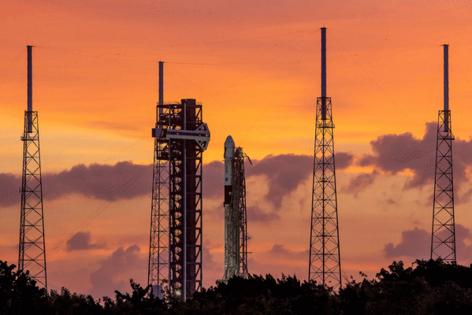With Hurricane Helene past, SpaceX to try 1st human spaceflight from Canaveral launch site
Published in News & Features
ORLANDO, Fla. — If weather cooperates, humans will be headed to space from a new launch pad on Saturday as SpaceX aims to send up the Crew-9 mission from its Cape Canaveral Space Force Station site for the first time.
NASA astronaut and Space Force Col. Nick Hague will command the two-person crew aboard SpaceX’s Crew Dragon Freedom joined by Roscosmos cosmonaut Aleksandr Gorbunov.
The duo aim to launch from Canaveral’s Space Launch Complex 40 at 1:17 p.m. Saturday marking the first time SpaceX will have sent humans to space from a pad other than Kennedy Space Center’s Launch Complex 39-A.
A planned Thursday launch was called off as Hurricane Helene was brewing, and the Space Coast was both under a tropical storm warning all day as well as nearby tornado warnings. KSC reported a high of a 62 mph gust at its nearby Launch Pad 39-B.
The first-stage booster for this mission is flying for its second time and will aim for a recovery at Canaveral’s Landing Zone 1, meaning one or more sonic booms may be heard along the Space Coast and into Central Florida.
Crew Dragon Freedom is making its fourth trip to space having flown first on the Crew-1 mission in 2020 followed by the Axiom Space Ax-2 and Ax-3 commercial missions, all having docked to the ISS.
Space Launch Delta 45’s weather squadron forecasts only a 55% chance for good launch conditions Saturday, which only improve to 60% if delayed to Sunday and 65% if delayed to Monday. The Sunday launch target is 12:54 p.m. with Monday’s at 12:32 p.m.
SpaceX constructed the new crew access arm at SLC-40 in 2023 to be able to have two Space Coast launch options, something NASA expressed a need for, especially after it voiced worries about potential damage that could be done the KSC pad if SpaceX brought on launches of its massive Starship and Super Heavy rockets.
“I’m extremely proud of this joint Commercial Crew Program and SpaceX team for all the hard work it took to get the pad certified in time,” said Dana Hutcherson, deputy program manager of NASA’s Commercial Crew Program after Crew-9’s arrival last Saturday to KSC. “This is a huge increase in capability for us with two pads now rated for human spaceflight, we now have operational flexibility with SpaceX to deconflict launches at both 39-A and SLC-40.”
The human spaceflight missions from the Mercury program launched from what was then Cape Kennedy’s Launch Complex 5 and 14. The Gemini program human missions launched from Launch Complex 19. The first crewed mission of the Apollo program, Apollo 7, launched from Cape Kennedy’s Launch Complex 34 while the rest of the 10 crewed missions as well as the three Skylab and all Space Shuttle Program missions flew from KSC’s LC-39A or 39B. Boeing Starliner’s Crew Flight Test launch in June from Canaveral’s Space Launch Complex 41 made it the seventh launch site on the Space Coast.
SpaceX’s SLC-40 will be the eighth.
Hague, who will become the first active Space Force service member to launch into space, said breaking in a new launch pad wasn’t part of the original plan as the mission was supposed to have launched in August from KSC.
Delays in the return of Boeing’s Starliner from the ISS and the need to prep KSC’s LC 39-A for a Falcon Heavy launch in October for NASA’s Europa Clipper mission to Jupiter’s icy moon Europa, forced SpaceX and NASA to pivot to Canaveral.
“So launching from SLC-40 is something new. It’s new and exciting, and so in the final preparations leading up to launch, one of the things we’re going to have to do is go out and do some familiarization with the emergency egress equipment on SLC-40. Previously, in July, we were out, and we were able to do that for Pad 39-A. The mission changed. We changed pads, and now we’re working off SLC-40.”
Part of this week’s preparations included a dry run and making sure everything was ready for the launch attempt.
“I think this new capability, this new launch pad, gives us more maneuverability, less scheduling conflict, and we’ll be able to launch easier,” added Gorbunov through a translator. “It’s probably going to have a positive effect on the operations on board the ISS. So the crew are going to be changing out regularly with no interruptions.”
SpaceX remains the only certified provider for ferry service to the International Space Station from the U.S. as Boeing’s Starliner, which launched from nearby SLC-41 atop a United Launch Alliance Atlas V rocket, has faced years of hurdles to complete its first crewed flight test.
The Crew-9 mission is flying with only two astronauts on the way up so that it can return with the Starliner CFT mission’s two passengers who were left behind when NASA opted to send it home earlier this month from the ISS minus the crew because of safety concerns over Starliner’s propulsion system.
While Starliner made a safe landing, NASA astronauts Butch Wilmore and Suni Williams remained on board and have become part of the ISS expedition crew. They won’t fly home until next February taking the two vacant seats aboard Crew Dragon Freedom on its return flight.
Hague send one of the mission’s priorities once they arrive on station will be to train up Wilmore and Williams with all they’ll need to know to fly on Crew Dragon.
“We have been in touch with with Butch and Suni, Hague said. “They are excited for us to get there.”
---------
©2024 Orlando Sentinel. Visit at orlandosentinel.com. Distributed by Tribune Content Agency, LLC.







Comments